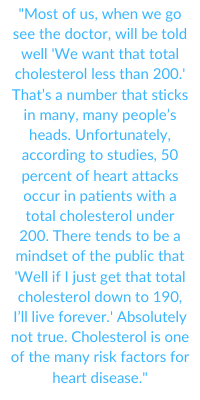Preventing Heart Disease
Dr. Rick Backes, cardiologist with the CentraCare Heart & Vascular Center, spoke with WJON's Jay Caldwell about the basics to having a healthy heart and how it starts early.
Jay Caldwell: Why is heart health so important?
Dr. Rick Backes: Half of us — both men and women — will ultimately die of cardiovascular disease. This is and continues to be the number one killer of Americans. The problem with it is that the disease tends to start in men in their 50s and women in their 60s. But the processes that lead to heart attacks actually begin in our teens and, now studies have shown, actually in our pre-teen years. Heart disease is not a disease that occurs suddenly, but it builds up over years and years.
The number one killer from a heart disease standpoint is what I call “simple plumbing.” It’s a disease that our grandparents would have called hardening of the arteries. In medicine, we call it atherosclerosis. You can call it cholesterol plaque, crud in the pipes, blockages, narrowing stenosis — all of those names mean the same thing. There’s a plumbing issue. The way God made us, we have three main arteries in the heart, and it is simply crud in those arteries that ultimately will lead to a heart attack, which is a completely plugged artery.
Again, the disease process starts in our teen and pre-teen years. So, a healthy lifestyle and the things we’ll talk about in a second are what we can do to try and prevent that. We cannot change our genetics and obviously genetics play a large role in cardiovascular disease. As of today, we can’t change it but there are a multitude of things we can do from a lifestyle standpoint.
Number one: Don’t smoke. Everybody knows that. But it is still increasing now in in our teenage years which is unfortunate with vaping, etc.
Try to cut out some of the fats, saturated fats in particular, in our diet.
 We need to exercise — every one of us should exercise at least three to five times per week. Aerobically and, at least a couple of times a week, we should do some resistance training. And that’s at all ages. You don’t have to run marathons. As you get older, just a simple walk. And ideally, if you can do something in a pool, that is great.
We need to exercise — every one of us should exercise at least three to five times per week. Aerobically and, at least a couple of times a week, we should do some resistance training. And that’s at all ages. You don’t have to run marathons. As you get older, just a simple walk. And ideally, if you can do something in a pool, that is great.
The other things are control our blood pressure, make sure our blood sugar is controlled, make sure our cholesterol is controlled. Unfortunately, in our society, all three of those are dominated by us being overweight. By simply controlling our weight, the vast majority of those three big risk factors will go away. And heart disease could decrease significantly.
Jay Caldwell: If you get into some bad habits as a teenager, is the assumption that that’s where heart disease may have started?
Dr. Rick Backes: Absolutely. There are studies done on teen and pre-teen kids, who have died of accidents. And when we open up the arteries of teens and preteens, you actually see the beginnings of that disease of atherosclerosis at that very young age. What we teach our kids is something that’s very difficult to grow out of as we get into middle age and older years. The disease doesn’t start one day when you turn 40 or 50 — it starts in our younger years. And as everybody knows, unfortunately, tobacco abuse also starts in those teenage years.
Jay Caldwell: Is there any sign that you have the beginnings of heart disease?
Dr. Rick Backes: Unfortunately, typically symptoms don’t start until the disease is very advanced. Usually, and there is some variability in this, but usually an artery has to be 70 percent narrowed before it will cause any symptoms whatsoever. So unfortunately for 10 to 20 percent of us, the first warning we have any type of heart problem is what’s called sudden cardiac death. Your neighbor just didn’t wake up one day. With technology advancing, there are some new tests available that can allow us to see that buildup of plaque or crud before we develop symptoms.
When I started, which was now 40 years ago, the only way to know if we had plaque on the inside of any degree was with what was called an invasive angiogram where we put a tube up a patient’s groin. We had stress testing. It’s been around for 50-60 years but that only finds blockages that are at least 70 percent. There are literally millions of people walking around with crud in their pipes upwards of 50 to 60 percent who have absolutely no symptoms.
Jay Caldwell: What is some of the new technology that we now have available to detect heart disease?
Dr. Rick Backes: Over the last several years there is new technology, not only in all of medicine, but in cardiology in particular that allows us to image the inside of our blood vessels, non-invasively, with the CT scanner. Now it’s a specific CT scanner that looks at the heart. Technology now allows us to look at the inside of the blood vessels in someone who has no cardiac symptoms and we can see that disease is in its infancy. When we see that, we can set up treatment programs because we’ve learned over the last 10 to 15 years, if we do the right things, we can shrink plaque. For the first 25-30 years that I was in medicine, we thought that atherosclerosis continued to develop no matter what we did. We know now if we do the right things, two-thirds to three-quarters of the time we can shrink those blockages without balloons, stints, etc.
Jay Caldwell: So lifestyle health changes can reduce the blockage in the heart?
Dr. Rick Backes: Absolutely. You may have to add a statin drug or something to that. There are two types the HDL, or healthy, and the LDL, or lousy cholesterol. We know now if we drive that lousy cholesterol down around 70 or less, we can absolutely shrink plaque.
Jay Caldwell: If our cholesterol levels are in the acceptable area, is that an indication of where we’re at as far as our heart health or is that just a small sample size?
Dr. Rick Backes: Unfortunately, that is a poor surrogate for heart health. Most of us, when we go see the doctor, will be told well “We want that total cholesterol less than 200.” That’s a number that sticks in many, many people’s heads. Unfortunately, according to studies, 50 percent of heart attacks occur in patients with a total cholesterol under 200. There tends to be a mindset of the public that “Well if I just get that total cholesterol down to 190, I’ll live forever.” Absolutely not true. Cholesterol is one of the many risk factors for heart disease.
You also need to get your blood pressure into an acceptable area. And if you have diabetes, you need to control your blood sugars. We can’t change genetics and that’s a big part of it. There’s no question.
Jay Caldwell: If you’re someone that has heart disease in your family, do you need to be especially aware of what you’re doing and doing all the preventative things?
Dr. Rick Backes: Absolutely. I preach this on a daily basis. If everyone in your family had a heart attack or stent or bypass around age 50, somewhere before then you need to be really worried and do everything you can control to prevent that from happening to you. I also recommend, now with the new technology available, we may want to do some imaging before you get to the age where the rest of the family was having problems.
Jay Caldwell: So, if that happened to be when one is in the 50s, should they have their imaging done when they were in their 40s?
Dr. Rick Backes: Yeah. That’s what I recommend. I lost several of my family members in their 50s to heart disease. So, for my 50th birthday, I did some cardiac testing to see where I was at.
Jay Caldwell: What’s involved in that testing?
Dr. Rick Backes: The CT scan literally takes 15 to 20 minutes. And for about 90 percent of patients we get beautiful images of those blood vessels surrounding your heart.
Common heart attack signs and symptoms
• Pressure, tightness, pain, or a squeezing or aching sensation in your chest or arms that may spread to your neck, jaw or back
• Nausea, indigestion, heartburn or abdominal pain
• Shortness of breath
• Cold sweat
• Fatigue
• Lightheadedness or sudden dizziness
Heart attack symptoms vary. If you suspect you’re having a heart attack, immediately call 911 or have someone bring you to the nearest emergency room.
